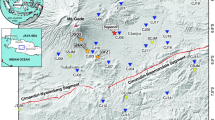Abstract
Results derived from processing of data of field observations in the epicentral zone of the Altai earthquake of 2003 are presented. Accurate location of aftershocks showed that their spatial distribution is in good agreement with the source rupture outcropping on the Earth’s surface. According to aftershock data, the source had a length of 75 km and a maximum width of 20 km and extended in the vertical direction for 17 km; the displacement in the source averaged 2.5 m. Clusters identified in the aftershock cloud define variously dipping planes. The location of hypocenters by regional, national, and global seismic networks is not accurate enough to examine spatial features of the aftershocks.
Similar content being viewed by others
References
A Set of Maps of the General Seismic Zoning of the Russian Federation on the Scale 1: 8 000 000 (OSR-97). Explanatory Note and the List of Cities and Inhabited Localities in Seismically Hazardous Areas, Ed. by V. I. Ulomov and L. S. Shumilina (OIFZ, Moscow, 1999) [in Russian].
S. S. Arefiev, E. A. Rogozhin, R. E. Tatevossian, et al., “The Neftegorsk (Sakhalin Island) 1995 Earthquake: A Rare Interplate Event,” Geophys. J. Int. 143, 595–607 (2002).
S. S. Arefiev, V. V. Pogrebchenko, Zh. Ya. Aptekman, et al., “Preliminary Results of Seismological Observations in the Epicentral Zone,” in The Strong Earthquake of September 27, 2003, in Altai: Preliminary Results (IFZ RAN, Moscow, 2004), pp. 61–67 [in Russian].
L. Dorbath, C. Dorbath, L. Rivera, et al., “Geometry, Segmentation and Stress Regime of the Spitak (Armenia) Earthquake from the Analysis of the Aftershock Sequence, Geophys. J. Int. 108, 309–328 (1992).
S. V. Gol’din, V. S. Seleznev, A. F. Emanov, et al., “The Chuya (Altai) Earthquake of 2003: Seismological Results,” in The Strong Earthquake of September 27, 2003, in Altai: Preliminary Results (IFZ RAN, Moscow, 2004), pp. 55–60 [in Russian].
E. Kissling, W. L. Ellsworth, D. Eberhart-Phillips, and U. Kradolfer, “Initial Reference Models in Local Earthquake Tomography,” J. Geophys. Res. 99, 19635–19646 (1994).
N. V. Kondorskaya and V. I. Ulomov, “Specialized Catalog of Earthquakes for the Seismic Zoning of North Eurasia,” in Main Achievements of the Schmidt United Institute of Physics of the Earth in 1992–1996 (OIFZ, Moscow, 1996), Vol. 1, pp. 108–109 (http://Socrates.wdcb.ru/scetac/) [in Russian].
W. H. Lee and J. C. Lahr, HYPO71 (Revised: A Computer Program for Determining Hypocenter, Magnitude, and First Motion Pattern of Local Earthquakes) (Open File Report No. 75–311, 1975) (http://pubs.er.usgs.gov/pubs/ofr/ofr75311).
R. L. Miller and J. S. Kahn, Statistical Analysis in the Geological Sciences (Wiley, New York, 1962; Mir, Moscow, 1965).
New Catalog of Earthquakes in the USSR from Ancient Time to 1975, Ed. by N. V. Kondorskaya and N. V. Shebalin (Nauka, Moscow, 1977) [in Russian].
E. A. Rogozhin, B. M. Bogachkin, Yu. V. Nechaev, et al., “New Evidence of Strong Earthquakes in the Mountainous Altai Region,” Fiz. Zemli, No. 3, 75–81 (1998) [Izvestiya, Phys. Solid Earth 34, 244–250 (1998)].
E. A. Rogozhin and S. G. Platonova, Source Zones of Strong Earthquakes in Gornyi Altai in the Holocene (OIFZ RAN, Moscow, 2002) [in Russian].
E. A. Rogozhin, A. N. Ovsyuchenko, A. R. Geodakov, and S. G. Platonova, “A Strong Earthquake of 2003 in Gornyi Altai,” Russ. J. Earth Sci. 5(6) (2003) (http://elpub.wdcb.ru/journals/rjes/v05/the03141/tje03141.htm).
E. A. Rogozhin, A. N. Ovsyuchenko, A. V. Marakhanov, et al., “The Tectonic Position and Geological Manifestations of the Altai, 2003, Earthquake,” in The Strong Earthquake of September 27, 2003, in Altai: Preliminary Results (IFZ RAN, Moscow, 2004) [in Russian].
N. V. Shebalin, C. Dorbath, and R. E. Tatevossian, “The Sizes, Shape, and Position of the Spitak Earthquake Source: Aftershocks and Macroseismic Evidence,” Izv. Akad. Nauk SSSR, Ser. Fiz. Zemli, No. 11, 18–26 (1991).
R. E. Tatevossian, “Macroseismic Studies in Russia,” in Essays of Geophysical Research (OIFZ RAN, Moscow, 2003), pp. 73–89 [in Russian].
Author information
Authors and Affiliations
Additional information
Original Russian Text © S.S. Arefiev, Zh.Ya. Aptekman, V.V. Bykova, I.V. Maiveev, A.G. Mikhin, S.G. Molotkov, K.G. Pletnev, V.V. Pogrebchenko, 2006, published in Fizika Zemli, 2006, No. 2, pp. 85–96.
Rights and permissions
About this article
Cite this article
Arefiev, S.S., Aptekman, Z.Y., Bykova, V.V. et al. The source and aftershocks of the Altai (Chuya) earthquake of 2003. Izv.-Phys. Solid Earth 42, 167–177 (2006). https://doi.org/10.1134/S1069351306020091
Received:
Issue Date:
DOI: https://doi.org/10.1134/S1069351306020091



